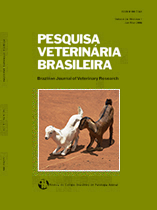 |
|
|
|
Year 2017 - Volume 37, Number 12
|

|
Malformations in small ruminants in the semi-arid region of Bahia: epidemiological, clinical-pathological and radiological aspects, 37(12):1437-1442
|
ABSTRACT.- Marcelino S.A.C., Macêdo J.T.S.A., Reis S.D.S., Lacerda M.S.C., Silva A.R.S., Riet-Correa F., Pimentel L.A. & Pedroso P.M.O. 2017. [Malformations in small ruminants in the semi-arid region of Bahia: epidemiological, clinical-pathological and radiological aspects.] Malformações em pequenos ruminantes no semiárido da Bahia: aspectos epidemiológicos, clínico-patológicos e radiológicos. Pesquisa Veterinária Brasileira 37(12):1437-1442. Laboratório de Patologia Veterinária, Fundação Universidade de Brasília, Campus Universitário Darcy Ribeiro, Via L4 Norte s/n, Brasília, DF 70910-970, Brazil. E-mail: pedrosovet@yahoo.com.br
The aim of this paper is to describe the epidemiological, clinical-pathological and radiological aspects of malformations in small ruminants in the semi-arid state of Bahia. Technical visits were carried out in 41 rural properties in the city of Uauá, Bahia, and in each of them, an epidemiological questionnaire was applied. In addition, when malformations were observed, the animals were evaluated alive or dead. Eight animals (1, 2, 3, 4, 5, 6, 7 and 8) were necropsied, and two (7 and 8) were submitted to radiographic examination. Regarding the feeding of the herd, 40 (97.56%) farmers reported the free access of their animals to the native vegetation. Regarding the presence of Mimosa tenuiflora, 5 (12.2%) said that the animals had access to the plant, 15 (36.6%) was informed they had little contact, while 21 (51.2%) reported that there was no contact with the plant, because this species were not present in a relevant number in the region. Twenty five out of 41 owners (60.98%) reported the consumption of Poincianella pyramidalis. It was also verified that in the majority of the properties there were many areas invaded by P. pyramidalis (80-90% of the vegetation). The main abnormalities reported by the interviewees on 36 properties were arthrogryposis (87.80%), agnatia [22 (53.66%)], lateral deviation of the mandible [11 (26.82%)], scoliosis [6 (14.63%)], micrognathia [6 (14.63%)], cleft palate [4 (9.75%)], skull enlarged in size [4 (9.75%)], microphthalmia [2 (4.88%)], braquignatism [1 (2.43%)], exophthalmia [1 (2.43%)] and, multiple deformities in the skull [1 (2.43%)]. In the clinical examination of 13 animals with malformations, the main alterations were bilateral arthrogryposis of the thoracic limbs (6/13); cleft lip (2/13); micrognathia (1/13) and dental malocclusion (1/13). Considering that some of these malformations were reproduced experimentally in goats, it is possible to suggest P. pyramidalis as another teratogenic plant for ruminants in Northeast Brazil. |
| |
|
|
| |
|
 |